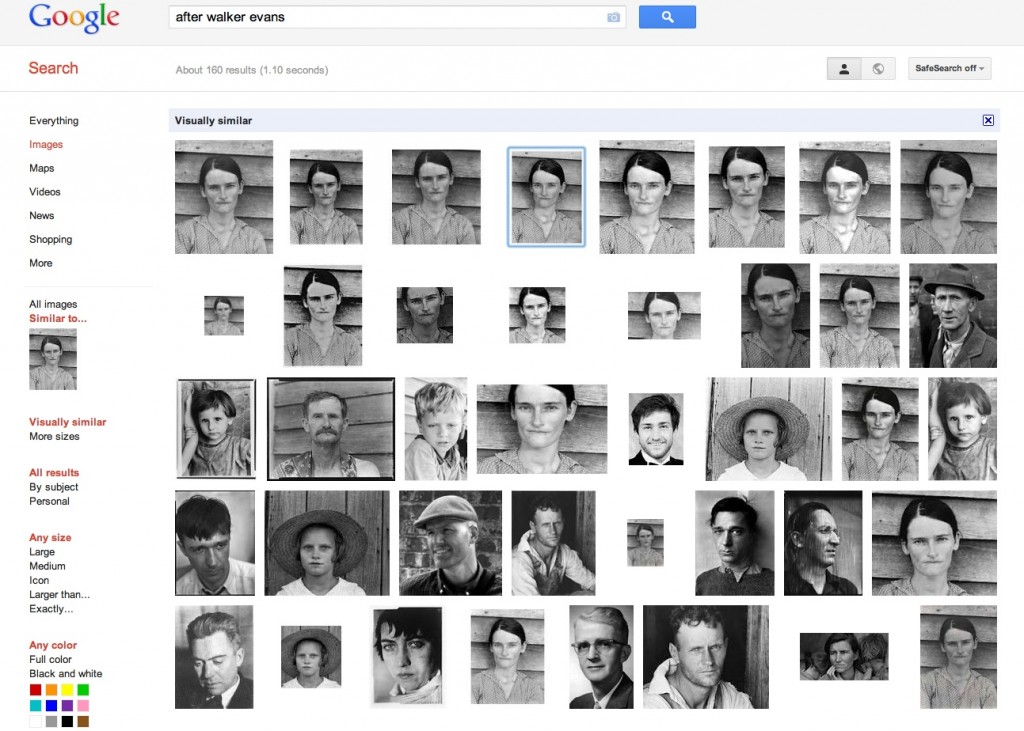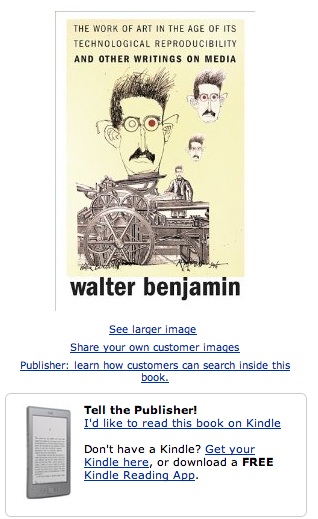Post Media Res: What the history of photography can teach us about digital piracy
Today the Internet has joined together to give us all a crash course in participatory politics. With two belligerent “anti-piracy” bills, SOPA and PIPA, waiting in the wings of Congress, a number of websites have turned their home pages into soapboxes to rally their users against the legislation. This controversy belongs to the decade’s history of sporadic but intense public outbursts of an interminable battle between the aging American content industry that distributes movies and music and the international network of digital communities that jeopardizes their business model. Metallica suing Napster, the arrest of PirateBay operators, even the Wikileaks controversy represents a version of this conflict between the two historic models of distribution. It’s like a giant endless bar fight that periodically spills into the street: one guy gets arrested from time to time, but more people are always piling in.
What is actually sustaining this brawl? How could it ever end? I think the history of photography can provide some clues.
First off, I don’t think the biggest obstacle facing the debate over digital piracy is that it suffers from some fatal disagreement over what to do with new technology, or even some kind of inter-generational gap in understanding about what such technology is capable of doing. I actually don’t think the biggest problem comes from disagreements of any kind. It’s the opposite. I think the digital piracy debate comes to loggerheads because the two sides tacitly agree on one faulty premise: that this debate is one about new technology. Beyond all their disagreements about specific policy, each side grounds their argument in the rhetoric of technological novelty and that’s what keeps their blinders on. For the conservative content-providers (e.g. the motion picture and recording industry associations) aggressive changes have to be made to existing copyright and piracy law to combat all the new threats digital media poses; the “progressive” community of artists and critics oppose such regulation on the basis that it undercuts all the new potential promised by digital media. Each side points to the same set of “emergent“ digital features–things like file-sharing, streaming, ect.–to support opposite conclusions about what ought to be done.
Recent technology has created new modalities for viewing, sharing, and repurposing and certain 20th century systems of content production and distribution feel threatened for the first time, but the shape of this socio-political crucible is timeless. And this is what the debate is missing: it isn’t about this or that technology its about the long-term social trends that produce the technology.I think you can pick any moment in the history of aesthetics and it will reveal the basic tension of the digital piracy issue: a confrontation between the rights of those who see and those who make things seen. I want to talk about the birth of photography in this context, not because I think it is any more relevant to digital debate than say the birth of the printing press, but because I think the history of photography, like every other medium, has specific features that can highlight corresponding details in the contemporary debate over digital piracy.
With that in mind, I want to ask an incredibly stupid question: what is the medium of photography?
There’s an easy case for saying something like photo-sensitive film or paper, or some combination of that and the “apparatus” of the camera. What else? Art Historian Rosalind Krauss makes the argument that a medium isn’t primarily determined by the physical make-up of its tools, but rather by any number of what she calls “technical supports.” The use of the term technical is a little confusing here because Krauss doesn’t mean any concrete machine or device but a related “systems of rules” or “conventions” controlled by more abstract entities, like the film industry or car culture. Accordingly, the medium of an artist like William Kentridge, who draws sinewy animations with graphite on paper, could be said to be the conventions of cel-based animation rather the his base physical tools. Thinking about a medium this way lets us move beyond discussing it as a function of technological tools and their material qualities; moreover, it lets us see how such tools actually develop in response to social conventions (“technical supports’)–how, for example, tracing paper comes to mean something different after the invention of animated cartoons.
So what’s the medium of photography? We could say it is, among other things, the convention of reproduction–not just the convention of making copies of any given negative, but also using photography to make reproductions of other works of art, like photos of paintings or sculpture. Nothing about physical qualities of what we call photography demands that it be used for reproduction in either of these two senses, its features seem to make such tasks easy, but the discovery of photo-sensitive chemicals didn’t force us to develop photography in that way anymore than the discover of colored pigments forced us to make easel paintings, instead of jars of colored water.
The reproductive possibilities of photography came to define the medium because its users wanted it that way. And while it would get me fatally off-subject to explain why I think they wanted it that way, all we have to do is look at the early criticism of photography to know that the medium was widely understood in terms of its conventions of reproduction rather than its physical features. The serious problem “the Arts” had with photography wasn’t that its artists used lenses or chemically-treated paper (painters use both of these too), but that its “art” seemed to be nothing more than the possibility of unlimited, unaltered reproduction. Walter Benjamin summarized the threat this posed to the traditional arts in his famous essay “the Work of Art in the Age of its Technological Reproducibility,” where he coined the term “aura” to describe the value a non-reproducible art object held in distinction to that of a photograph. Aura was a function of originality, of a work’s ability to confidently show that it had a straight-forward relationship to the original individual and historical context that made it–in other words, to have aura was to have authenticity. The problem was, photography not only made aura-less images of the world (because they could be infinitely copied from their negatives), it also drained formerly unique works like paintings and sculptures of their here-and-nowness–their aura–by fixing their likeness in a reproducible form. To compensate for the loss of aura, Benjamin thought the photograph’s reproductive capabilities offered untold new potential for the “social function of art,” that Art’s production and reception could be greatly democratized now that its uniqueness (rarity) could no longer be protected. But for many of his contemporaries, the loss of auratic “authenticity” was, at least initially, a threat to the basic meaning (let alone monetary value) of all Art.
Doesn’t this mourning for authenticity continue today? How often today do we hear the complaint that “no one” sees works of art in their “original” form anymore, and that “no one” attributes any value to originality or authenticity anymore?
Contemporary anti-piracy advocates express these concerns as a function of money, or euphemistically as questions of “intellectual property”, rather than in the aesthetic terms of Benjamin’s times, but the complaint is basically the same thing: unfettered reproduction destroys the authenticity and therefore value of “art” (congrats, Justin Bieber, you’ve made it!).
The thing is, for the most part, the “progressive” opposition disagrees with the math but not the formula, they often say: yes, copying a work might theoretically threaten the value of that work, but you can’t really copy the whole work, so stop trying to limit technology (which has other important functions) and start focusing on increasing the value of the unique remainder that can’t be captured by it. On the one hand, people point to bands like Radiohead who sell expensive (non-digitally reproducible) physical packages for their work or continue to make money off live performances; and on the other, they encourage companies that provide uniquely valuable service features like fast, reliable web stores (iTunes, Amazon, ect.).
Both sides cling to the idea that for something to be valuable it need be rarefied, or at least “authentic”– but what they rarely discuss is that over the course of the history of man-made art, value has only recently come to be defined this way. As weird as it sounds, it is very hard to find evidence for the existence of our idea of “authenticity” before the 16th century in Western culture. Up until that relatively recent point, no one really cared if a work of art was authentic or not; it was far more important that a work of art fulfill its sacred function and to do that a work of art needed only superficial resemblance to the “original”–a painting of the Virgin Mary that everyone knew was made yesterday could enjoy the same cultural value as the mythical original sketch of Mary made by St. Luke as long as it looked the part.
My point is: if authenticity could suddenly enter the picture, why couldn’t it suddenly leave? It happened with photography. It took a while, but no one really questions photography’s place in the High Arts any more, not even the auction houses. Though questions of fakes and copies still swirl for particular works, in terms of medium, the Art world has made its peace with passing of authenticity. The world of digital content is learning a similar lesson the hard way–SOPA and PIPA are the death-knells of an industry that is being dragged kicking and screaming, not into the “future” but into an epiphany of the past. The reason it’s hard to see this connection at first is because no one is thinking critically about what the medium of digital media is–both parties in this debate assume the medium of any given digital technology is the new technology itself, it’s not. The medium is the set of social and political conventions that we have developed around sharing generally and these have their roots in the historical crises of political aesthetics (e.g. the emergence of photography). This is why these types of debates are always over before they even start–realistically, only a fool (or someone who is paid to act like one) thinks that digital piracy can be stopped, that the content industry can go back to the “good ole’ days”. When a “new” technology emerges to threaten the status-quo it is already too late to put the genie back in the bottle. The emergence of a technology like peer-to-peer file-sharing wasn’t the first step in a process of innovations about sharing it was one of the last. Technologies are prefigured by the demands of their communities; a medium produces its physical surrogate. By the time an industry gets around to addressing a given problem as a technological one, they are already too late.
The medium isn’t the message. The medium was the message, and they missed it.


